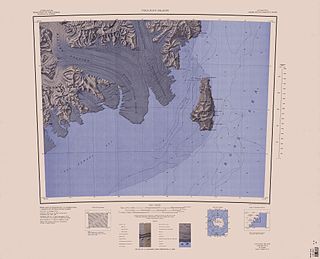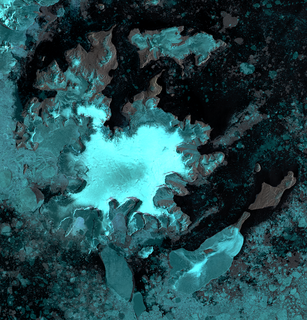Related Research Articles

Thurston Island is an ice-covered, glacially dissected island, 215 km (134 mi) long, 90 km (56 mi) wide and 15,700 km2 (6,062 sq mi) in area, lying a short way off the northwest end of Ellsworth Land, Antarctica. It is the third largest island of Antarctica, after Alexander Island and Berkner Island.

James Ross Island is a large island off the southeast side and near the northeastern extremity of the Antarctic Peninsula, from which it is separated by Prince Gustav Channel. Rising to 1,630 metres (5,350 ft), it is irregularly shaped and extends 64 km in a north–south direction. It was charted in October 1903 by the Swedish Antarctic Expedition under Otto Nordenskiöld, who named it for Sir James Clark Ross, the leader of a British expedition to this area in 1842 that discovered and roughly charted a number of points along the eastern side of the island. The style, "James" Ross Island is used to avoid confusion with the more widely known Ross Island in McMurdo Sound.

Arthur Harbour is a small harbour entered between Bonaparte Point and Amsler Island on the south-west coast of Anvers Island in the Palmer Archipelago of Antarctica.

Borchgrevink Glacier is a large glacier in the Victory Mountains, Victoria Land, draining south between Malta Plateau and Daniell Peninsula, and thence projecting into Glacier Strait, Ross Sea, as a floating glacier tongue, the Borchgrevink Glacier Tongue, just south of Cape Jones. It was named by the New Zealand Geological Survey Antarctic Expedition, 1957–58, for Carsten Borchgrevink, leader of the British Antarctic Expedition, 1898–1900. Borchgrevink visited the area in February 1900 and first observed the seaward portion of the glacier.

Aagaard Glacier, also known as Glaciar Alderete, is an 8-mile (13 km) long Antarctic glacier which lies close to the east of Gould Glacier and flows in a southerly direction into Mill Inlet, on the east coast of Graham Land. It was charted by the Falkland Islands Dependencies Survey (FIDS) and photographed from the air by the Ronne Antarctic Research Expedition during December 1947; it was named by the FIDS for Bjarne Aagaard, a Norwegian authority on Antarctic whaling and exploration.

Zinberg Glacier is a glacier in east Thurston Island; it flows east-northeast into Morgan Inlet between Tierney Peninsula and the promontory ending in Ryan Point. Named by Advisory Committee on Antarctic Names (US-ACAN) after Cpl. E. Zinberg, U.S. Army photographer in the Eastern Group of U.S. Navy Operation Highjump, which obtained aerial photographs of Thurston Island and adjacent coastal areas, 1946–47.

Ineson Glacier is a glacier flowing northwest into Gin Cove, James Ross Island, Antarctica. Following geological work by the British Antarctic Survey (BAS), 1981–83, it was named by the UK Antarctic Place-Names Committee after Jonathan R. Ineson, a BAS geologist in the area.

Attlee Glacier is a glacier 8 miles (13 km) long, which flows east-southeast from the plateau escarpment on the east side of Graham Land to the head of Cabinet Inlet to the north of Bevin Glacier.

Lawrie Glacier is a glacier flowing between Mount Genecand and Mezzo Buttress, and entering the head of Barilari Bay between Cherkovna Point and Prestoy Point on the west coast of Graham Land, Antarctica. It was charted by the British Graham Land Expedition under Rymill, 1934–37, and was named by the UK Antarctic Place-Names Committee in 1959 for Robert Lawrie, an English alpine and polar equipment specialist.

Boydell Glacier is a glacier on Trinity Peninsula in northern Graham Land. It is about 9 miles (14 km) long, flowing southeastward from Detroit Plateau to enter Sjögren Inlet in Prince Gustav Channel north of the terminus of Sjögren Glacier and 6 miles (10 km) west of Mount Wild. It was mapped by the Falkland Islands Dependencies Survey from surveys (1960–61), and named by the UK Antarctic Place-Names Committee for James Boydell, English inventor of a steam traction engine, the first practical track-laying vehicle.
Crabeater Point is a headland at the southeast extremity of Mobiloil Inlet, 4 nautical miles (7 km) east of Victory Nunatak, on the east coast of the Antarctic Peninsula. The point, the northwest extremity of a prominent ridge, was photographed from aircraft of the United States Antarctic Service on September 28, 1940, and by the Ronne Antarctic Research Expedition, December 22, 1947. It was surveyed in December 1958 by the Falkland Islands Dependencies Survey who gave the descriptive name. The ridge of which this point is the extremity resembles a recumbent crabeater seal when seen from the air.
Cronus Glacier is a glacier 6 nautical miles (11 km) long and 3 nautical miles (6 km) wide flowing northwest into Bowman Inlet between the Calypso Cliffs and Crabeater Point on the east coast of the Antarctic Peninsula. It was photographed by the Ronne Antarctic Research Expedition on December 22, 1947, and roughly surveyed by the Falkland Islands Dependencies Survey in December 1958. It was named by the UK Antarctic Place-Names Committee after Cronus, the god of agriculture in Greek mythology.
Mount Early is a solitary volcanic cone, 2,720 metres (8,920 ft) high, standing 13 nautical miles (24 km) north of D'Angelo Bluff, on the west side and near the head of Scott Glacier. It was discovered in December 1934 from nearby Mount Weaver by the Byrd Antarctic Expedition geological party led by Quin Blackburn. It was visited by the Ohio State University geological party led by George Doumani on November 21, 1962, and was named by the Advisory Committee on Antarctic Names after Captain Neal E. Early, US Army, a member of the aviation unit that supported the United States Geological Survey Topo East survey of this area, 1962–63.

Lofgren Peninsula is an ice-covered peninsula about 22 nautical miles (40 km) long, projecting between Cadwalader Inlet and Morgan Inlet on the northeast side of Thurston Island, Antarctica. The northern extremity of the peninsula is Cape Menzel, a bold rock cape. These features were discovered in helicopter flights from the USS Burton Island and the USS Glacier of the U.S. Navy Bellingshausen Sea Expedition in February 1960, and was named by the Advisory Committee on Antarctic Names. The peninsula was named for Charles E. Lofgren, personnel officer with the Byrd Antarctic Expedition, 1928–30. The cape was named for Reinhard W. Menzel, a geomagnetist-seismologist with the Eights Station winter party, 1965.

Litz Glacier is a glacier flowing northeast from the vicinity of Smith Peak and Litz Bluff in north-central Thurston Island, Antarctica. The glacier enters the west part of Peale Inlet north of the Guy Peaks. It was named by the Advisory Committee on Antarctic Names after A.K. Litz, Chief Photographer's Mate in the Eastern Group of Operation Highjump, which obtained aerial photographs of this glacier and adjacent coastal areas, 1946–47.
The Hitchcock Heights are a mostly ice-covered mountain mass, 1,800 metres (5,900 ft) high, between Maitland Glacier and Apollo Glacier at the south side of Mobiloil Inlet, on the east coast of the Antarctic Peninsula. They were discovered and photographed by Sir Hubert Wilkins on his flight of December 20, 1928, and rephotographed by Lincoln Ellsworth in 1935. The feature was named by the Advisory Committee on Antarctic Names in 1952 for Charles B. Hitchcock of the American Geographical Society, who by utilizing these photographs assisted in constructing the first reconnaissance map of this area.
Hero Inlet is a narrow inlet at the south side of Palmer Station between Gamage Point and Bonaparte Point, along the southwest side of Anvers Island in Antarctica. It was named by the Advisory Committee on Antarctic Names after the Research Vessel Hero which, during the 1960s and 1970s, used the inlet as a turning basin when docking at Palmer Station.

Rexford Glacier is a glacier flowing northeast into the head of Wagoner Inlet on the north side of Thurston Island. Named by Advisory Committee on Antarctic Names (US-ACAN) after Aviation Radioman Phillip W. Rexford, PBM Mariner aircrewman in the Eastern Group of U.S. Navy Operation Highjump, which obtained aerial photographs of this glacier and adjoining coastal areas, 1946–47.
Rowland Glacier is a glacier on the north side of the Frigate Range, flowing east into Lowery Glacier. Mapped by the United States Geological Survey (USGS) from tellurometer surveys and Navy air photos, 1960–62. Named by Advisory Committee on Antarctic Names (US-ACAN) for Robert W. Rowland, United States Antarctic Research Program (USARP) glaciologist at South Pole Station, 1962–63 and 1963–64.
League Rock is a distinctive rounded rock lying southwest of Box Reef, off the south end of Adelaide Island, Antarctica. It was surveyed by the Royal Navy Hydrographic Survey Unit, 1962–63, and was so named by the UK Antarctic Place-Names Committee because the rock lies one league distant from what was then Adelaide Station.
References
- ↑ "Gamage Point". Geographic Names Information System . United States Geological Survey . Retrieved 2012-04-16.
![]() This article incorporates public domain material from the United States Geological Survey document: "Gamage Point".(content from the Geographic Names Information System ) Coordinates: 64°46′S64°4′W / 64.767°S 64.067°W
This article incorporates public domain material from the United States Geological Survey document: "Gamage Point".(content from the Geographic Names Information System ) Coordinates: 64°46′S64°4′W / 64.767°S 64.067°W